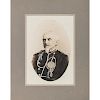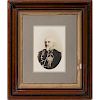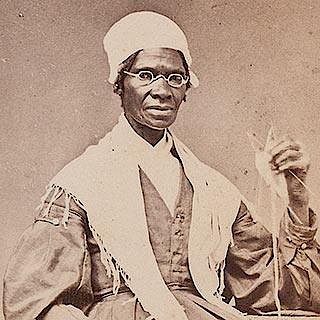Charles De Rudio, 7th Cavalry, Cabinet Card by D.F. Barry
About Seller
6270 Este Ave.
Cincinnati , OH 45232
United States
With offices in Cincinnati, Cleveland and Denver, Cowan’s holds over 40 auctions each year, with annual sales exceeding $16M. We reach buyers around the globe, and take pride in our reputation for integrity, customer service and great results. A full-service house, Cowan’s Auctions specializes in Am...Read more
Two ways to bid:
- Leave a max absentee bid and the platform will bid on your behalf up to your maximum bid during the live auction.
- Bid live during the auction and your bids will be submitted real-time to the auctioneer.
Bid Increments
| Price | Bid Increment |
|---|---|
| $0 | $25 |
| $500 | $50 |
| $1,000 | $100 |
| $2,000 | $250 |
| $5,000 | $500 |
| $10,000 | $1,000 |
| $20,000 | $2,500 |
| $50,000 | $5,000 |
| $100,000 | $10,000 |
About Auction
Jun 9, 2017 - Jun 10, 2017
Cowan's Auctions dawnie@cowans.com
- Lot Description
Cabinet card of Charles De Rudio, blindstamped twice by Barry, with Barry's Superior, WI label on back of mat. Housed in wood frame, 12 x 14 in.
Italian-born aristocrat Charles De Rudio (1832-1910) joined the Italian patriots in the 1848 uprising at the age of 15 and helped defend Rome and Venice against the Austrians. In 1858, he was part of the famous Orsini Plot which sought to assassinate Napoleon III with a bomb. While Orsini and two others were hanged, De Rudio was sentenced to Devil's Island, from which he soon escaped with about a dozen other prisoners.
Just prior to the start of the Civil War, De Rudio emigrated to New York and volunteered with the 79th New York Volunteers, serving at the Siege of Petersburg. He was then commissioned 2nd lieutenant in the 2nd USCT, with which he served until January 1866 when he was honorably discharged. A little over a year later, he received an appointment to the 7th Cavalry. Initially a 2nd lieutenant in Co. H, Benteen's unit, he later was promoted to 1st lieutenant in Co. E. This was the position he held during the 1876 Battle of the Little Bighorn. Assigned to Reno's Battalion, De Rudio survived the battle.
__________________________________________________________________________________________________
Charles De Rudio was one of the more colorful characters in the 7th Cavalry, a unit full of colorful characters. Carlo Camillo Di Rudio (1832-1910) was born in Belluno, Italy. His later education was in a military academy in Milan. At 15 he joined the Italian patriots (1848) and helped defend Rome and Venice against the Austrians. In 1855 he was living in East London, where he married Eliza, the daughter of a confectioner, and herself an embroiderer in the lace industry, then only 15 years of age. In 1858, three bombs were thrown at the procession of Emperor Louis Napoleon (Napoleon III). Among the four arrested was De Rudio, then using the name "Da Selva." The leader of the assassination plot and two of the henchmen were sentenced to be guillotined. Two were executed, but De Rudio had his sentence commuted to life on Devil's Island, from which he soon escaped with about a dozen others. He made his way to British Guiana, thence back to London to his wife and family. It appears to be about this time that he anglicized his name to "Charles De Rudio." De Rudio had had a couple of other colorful encounters prior to this incident, including being nearly assassinated himself in a restaurant in London, surviving an attack in which he received a reported 36 stab wounds. The attack was violent enough that it was reported by the Times.
Just prior to the start of the American Civil War, De Rudio emigrated to New York. He volunteered with the 79th New York Vols. and served at the Siege of Petersburg. He was then commissioned 2nd Lieut. in the 2nd USCT, with which he served until Jan. 1866 when he was honorably discharged. He requested a regular army commission, but failed his first physical. (Some think he did not really fail the physical, but that the Army uncovered his earlier police record and had to decide what to do with him, since he had served well in the U.S.)
He did receive a commission a month later and served until the size of the Army was reduced (to just over half of its earlier size). De Rudio was among those initially "downsized." A few months later he received an appointment to the 7th Cavalry. Initially a 2nd Lieut. in Co. H, Benteen's unit, he later was promoted to 1st Lieut. in Co. E. De Rudio was not particularly liked by the other officers, nominally because of a haughty manner, although he was described as a good officer, not one to drink or gamble, and clearly educated in military science. After his appointment, Custer put one of his favorites, 1st Lieut. Algernon Smith, in charge of Co. E and put De Rudio in Co. A as Smith's replacement.
Co. A was in Reno's command. Reno crossed the Little Bighorn early in the battle and dismounted along a skirmish line fighting primarily Hunkpapa and Oglala Sioux who had rushed to defend the village. As the number of native warriors increased, Reno decided to find a more defensible position. He recrossed the river, but De Rudio and Thomas O'Neill lost their horses and remained hidden in the timber along the river throughout the battle. They hid for 36-hours until the opportunity arose to cross the river and rejoin Reno. (Some of the embellished/exaggerated accounts of their time in the timber were published without De Rudio's knowledge or approval, or so he claimed.) Lt. Smith was with Custer and did not survive the battle.
De Rudio continued in service, fighting the Nez Perce among others. He served at Fort Meade (D.T.), Fort Sam Houston (TX) and Fort Bayard (NM). He retired (by age) as a major in San Diego, CA, in 1896, and died in Pasadena in 1910.
A few chips to gesso. Card appears to be fine.Condition
- Shipping Info
-
SHIPPING. At the request of the buyer, Cowan's will authorize the shipment of purchased items. Shipments usually occur within two weeks after payment has been received. Shipment is generally made via UPS Ground service. Unless buyer gives special instructions, the shipping method shall be at the sole discretion of Cowan's Auctions, Inc.. Cowan's is in no way responsible for the acts or omissions of independent handlers, packers or shippers of purchased items or for any loss, damage or delay from the packing or shipping of any property.
-
- Buyer's Premium



 EUR
EUR CAD
CAD AUD
AUD GBP
GBP MXN
MXN HKD
HKD CNY
CNY MYR
MYR SEK
SEK SGD
SGD CHF
CHF THB
THB












